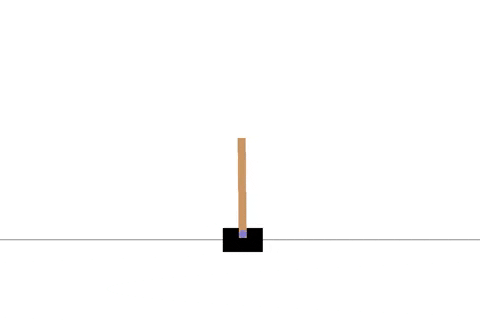Actor Critic Method
Introduction
An implementation of Actor Critic method on CartPole-V0 environment.
Actor Critic Method
As an agent takes actions and moves through an environment, it learns to map the observed state of the environment to two possible outputs:
- Recommended action: A probabiltiy value for each action in the action space. The part of the agent responsible for this output is called the actor.
- Estimated rewards in the future: Sum of all rewards it expects to receive in the future. The part of the agent responsible for this output is the critic.
Agent and Critic learn to perform their tasks, such that the recommended actions from the actor maximize the rewards.
CartPole-V0
A pole is attached to a cart placed on a frictionless track. The agent has to apply force to move the cart. It is rewarded for for every time step the pole remains upright. The agent, therefore, must learn to keep the pole from falling over.
import gym
import numpy as np
import tensorflow as tf
from tensorflow import keras
from tensorflow.keras import layers
# Configuration paramaters for the whole setup
seed = 42
gamma = 0.99 # Discount factor for past rewards
max_steps_per_episode = 10000
env = gym.make("CartPole-v0") # Create the environment
env.seed(seed)
eps = np.finfo(np.float32).eps.item() # Smallest number such that 1.0 + eps != 1.0
Implement Actor Critic network
This network learns two functions:
- Actor: This takes as input the state of our environment and returns a probability value for each action in its action space.
- Critic: This takes as input the state of our environment and returns an estimate of total rewards in the future.
In our implementation, they share the initial layer.
num_inputs = 4
num_actions = 2
num_hidden = 128
inputs = layers.Input(shape=(num_inputs,))
common = layers.Dense(num_hidden, activation="relu")(inputs)
action = layers.Dense(num_actions, activation="softmax")(common)
critic = layers.Dense(1)(common)
model = keras.Model(inputs=inputs, outputs=[action, critic])
Train
optimizer = keras.optimizers.Adam(learning_rate=0.01)
huber_loss = keras.losses.Huber()
action_probs_history = []
critic_value_history = []
rewards_history = []
running_reward = 0
episode_count = 0
while True: # Run until solved
state = env.reset()
episode_reward = 0
with tf.GradientTape() as tape:
for timestep in range(1, max_steps_per_episode):
# env.render(); Adding this line would show the attempts
# of the agent in a pop up window.
state = tf.convert_to_tensor(state)
state = tf.expand_dims(state, 0)
# Predict action probabilities and estimated future rewards
# from environment state
action_probs, critic_value = model(state)
critic_value_history.append(critic_value[0, 0])
# Sample action from action probability distribution
action = np.random.choice(num_actions, p=np.squeeze(action_probs))
action_probs_history.append(tf.math.log(action_probs[0, action]))
# Apply the sampled action in our environment
state, reward, done, _ = env.step(action)
rewards_history.append(reward)
episode_reward += reward
if done:
break
# Update running reward to check condition for solving
running_reward = 0.05 * episode_reward + (1 - 0.05) * running_reward
# Calculate expected value from rewards
# - At each timestep what was the total reward received after that timestep
# - Rewards in the past are discounted by multiplying them with gamma
# - These are the labels for our critic
returns = []
discounted_sum = 0
for r in rewards_history[::-1]:
discounted_sum = r + gamma * discounted_sum
returns.insert(0, discounted_sum)
# Normalize
returns = np.array(returns)
returns = (returns - np.mean(returns)) / (np.std(returns) + eps)
returns = returns.tolist()
# Calculating loss values to update our network
history = zip(action_probs_history, critic_value_history, returns)
actor_losses = []
critic_losses = []
for log_prob, value, ret in history:
# At this point in history, the critic estimated that we would get a
# total reward = `value` in the future. We took an action with log probability
# of `log_prob` and ended up recieving a total reward = `ret`.
# The actor must be updated so that it predicts an action that leads to
# high rewards (compared to critic's estimate) with high probability.
diff = ret - value
actor_losses.append(-log_prob * diff) # actor loss
# The critic must be updated so that it predicts a better estimate of
# the future rewards.
critic_losses.append(
huber_loss(tf.expand_dims(value, 0), tf.expand_dims(ret, 0))
)
# Backpropagation
loss_value = sum(actor_losses) + sum(critic_losses)
grads = tape.gradient(loss_value, model.trainable_variables)
optimizer.apply_gradients(zip(grads, model.trainable_variables))
# Clear the loss and reward history
action_probs_history.clear()
critic_value_history.clear()
rewards_history.clear()
# Log details
episode_count += 1
if episode_count % 10 == 0:
template = "running reward: {:.2f} at episode {}"
print(template.format(running_reward, episode_count))
if running_reward > 195: # Condition to consider the task solved
print("Solved at episode {}!".format(episode_count))
break
Visualizations
In early stages of training:

In later stages of training:
